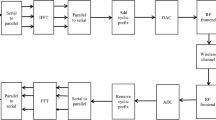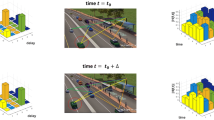Abstract
This paper addresses the challenging issue of joint maximum-likelihood estimation of carrier frequency offset, timing offset and channel response for orthogonal frequency division multiple access (OFDMA) uplink transmissions. A pilot preamble based approach is proposed that makes use of the concept of signal decomposition. Earlier works have demonstrated that it is possible to decompose the multidimensional optimization involved in this joint estimation problem into a series of one-dimensional searches. However, the computational complexity involved with such methods is also very high. In this work, we propose a new signal decomposition method based on a minimum residue criterion. The method with appropriate signal structures provides a computationally-efficient solution for the joint estimation of all required parameters of all users at the base station in an OFDMA link, leading to energy-efficient system design. Another advantage of the proposed technique is that it offers the flexibility of application to OFDMA systems with any subcarrier assignment scheme. Performance advantages of the proposed estimation method are substantiated through extensive computer simulation studies and are compared with that of some important recently-developed algorithms for the problem. Proof of convergence of the new estimation algorithm is also illustrated.









Similar content being viewed by others
References
IEEE LAN/MAN Standards Committee. (2004). IEEE standard for local and metropolitan area networks, Part 16: Air interface for xed broadband wireless access systems, (online). Accessed as: http://voiplab.niu.edu.tw/IEEE/802.16/802.16-2004
Bolton, W., Xiao, Y., & Guizani, M. (2007). IEEE 802.20: Mobile broadband wireless access. IEEE Transactions on Wireless Communications., 14(2), 84–95.
Cordeiro, C., Challapali, K., & Birru, D. (2006). IEEE 802.22: An introduction to the first wireless standard based on cognitive radios. Journal of Communications, 1(1), 38–47.
del-Castillo, J. I., Santos, M. A., & Villalón, J. M. (2013). Evaluation of OFDMA resource allocation algorithms in broadband wireless access networks. Springer Journal on Telecommunication Systems, 52, 27212732.
Eguizábal, M., & Hernndez, Á. (2015). Resource allocation and interference management strategies for inband relaying in LTE-A. Springer Journal on Telecommunication Systems. doi:10.1007/s11235-015-0040-7.
Yin, H., & Alamouti, S. (2006). OFDMA: A broadband wireless access technology. In Proceedings of IEEE Sarno Symposium (pp. 1–4).
Hwang, T., Yang, C., Wu, G., Li, S., & Li, G. Y. (2009). OFDM and its wireless applications: A survey. IEEE Transactions on Vehicular Technology, 58(4), 1673–1694.
Morelli, M., Jay Kuo, C.-C., & Pun, M. O. (2007). Synchronization techniques for orthogonal frequency division multiple access (OFDMA): A tutorial review. Proceedings of the IEEE, 95(7), 1394–1427.
Fessler, J. A., & Hero, A. O. (1994). Space-alternating generalized expectation maximization algorithm. IEEE Transactions on Signal Processing, 42(10), 2664–2677.
Pun, M. O., Morelli, M., & Kuo, C.-C. J. (2006). Maximum-likelihood synchronization and channel estimation for OFDMA uplink transmissions. IEEE Transactions on Communication, 54(4), 726–736.
Pun, M. O., Morelli, M., & Kuo, C.-C. J. (2007). Iterative detection and frequency synchronization for OFDMA uplink transmissions. IEEE Transactions on Wireless Communication, 6(2), 629–639.
Chen, J., Wu, Y., Chan, & Ng, T. (2008). Joint maximum-likelihood CFO and channel estimation for OFDMA uplink using importance sampling. IEEE Transactions on Vehicular Technology, 57(6), 3462–3470.
Häring, L., Bieder, S., Czylwik, A., & Kaiser, T. (2010). Estimation algorithms of multiple channels and carrier frequency offsets in application to multiuser OFDM systems. IEEE Transactions on Wireless Communication, 9(3), 865–870.
Junqi, G., Yong, S., Shubo, R., & Haige, X. (2010). Joint estimation of synchronization parameters and channels for generalized-OFDMA uplink. Chinese Journal of Electronics, 19(4), 737–742.
Du, R., & Wang, J. (2012). Novel blind CFO estimator for uplink interleaved OFDMA systems. International Journal of Digital Content Technology and its Applications (JDCTA), 6(3), 158–166.
Zhang, W., Gao, F., Yin, Q., & Nallanathan, A. (2012). Blind carrier frequency offset estimation for interleaved OFDMA uplink. IEEE Transactions on Signal Processing, 60(7), 3616–3627.
Zeng, X. N., & Ghrayeb, A. (2009). Joint CFO and channel estimation for OFDMA uplink: An application of the variable projection method. IEEE Transactions on Wireless Communication, 8(5), 2306–2311.
Golub, G., & Pereyra, V. (2003). Separable nonlinear least squares: the variable projection method and its applications. Inverse Problems, 19, R1–R26.
Thafasal Ijyas, V. P., & Sameer, S. M. (2013). A novel joint ML technique for estimation of timing, CFO and channel in OFDMA uplink. Proceedings of IEEE TENCON Spring Conference 2013 (pp. 227–231).
Thafasal Ijyas, V. P., & Sameer, S. M. (2013). Cramer–Rao bound for joint estimation problems. IET Electronics Letters, 49(6), 427–428.
Moeneclaey, M. (1998). On the true and the modified Cramer–Rao bounds for the estimation of a scalar parameter in the presence of nuisance parameters. IEEE Transactions on Communication, 46(2), 1536–1544.
Speth, M., Fechtel, S., Fock, G., & Meyr, H. (1999). Optimum receiver design for wireless broadband systems using OFDM-part I. IEEE Transactions on Communication, 47(4), 1668–1677.
Thafasal Ijyas, V. P., & Sameer, S. M. (2014). A rey algorithm for joint ML estimation of carrier frequency offsets and channel in OFDMA uplink. Wireless Personal Communications. doi:10.1007/s11277-014-1873-1
Author information
Authors and Affiliations
Corresponding author
Appendix: Proof of convergence of MRD algorithm
Appendix: Proof of convergence of MRD algorithm
In this Appendix, we prove that the value of the cost function for the mth user decreases in successive iterates. From Eqs. (28) and (34), this implies that the separation of the mth user’s cost function becomes more distortionless through consecutive iterations. Thus the cost function in the \((i+1)\)th iteration will give a better estimate than the cost function in the ith iteration. The cost function in the ith iteration for the mth user is,
Substituting the expression for \(\mathbf W _{m}^{(i)}\) in Eq. (36), we get
The \(\mathbf P \) and \([\mathbf I - \mathbf P ]\) matrices satisfy the properties of idempotent projection matrices. Hence \(\mathbf W _{(m)}^{(i)H}\left[ \mathbf I - \mathbf P _{(m)}^{(i-1)}\right] \mathbf W _{(m)}^{(i)}\) is less positive than the positive definite matrix, \(\mathbf W _{(m-1)}^{(i)H}\left[ \mathbf I - \mathbf P _{(m-1)}^{(i)}\right] \mathbf W _{(m-1)}^{(i)} \). Due to the iterative update procedure adopted in the algorithm, this means that
A graphical representation of the efficacy of the separation operation and convexity of the separated objective functions for the case of four users is shown in Fig. 9. The cost functions are plotted with high resolution values of the CFOs in the x-axis, to reveal the finer variations. Successive CFO values have a difference of 0.0001. Figure 9a depicts the behavior of the separated cost functions for all four users after two iterations and Fig. 9b after four iterations. It can be seen that the separated cost functions are smooth and convex in nature, whose optimum values can be easily determined using any suitable one-dimensional optimization procedure. The plotted minimum values move closer towards the actual CFO values to be estimated with more number of iterations. The figure also corroborates Eq. (53). This is so because the minimum of each separated cost function which corresponds to the best estimate possible from it decreases with more number of iterations. Also, such a descent in the value of the separated cost functions gives better estimates for all users.
Rights and permissions
About this article
Cite this article
Thafasal Ijyas, V.P., Sameer, S.M. Pilot-based joint ML estimation of timing offset, CFO and channel for OFDMA uplink using minimum residue decomposition technique. Telecommun Syst 65, 649–661 (2017). https://doi.org/10.1007/s11235-016-0258-z
Published:
Issue Date:
DOI: https://doi.org/10.1007/s11235-016-0258-z




